The most irritating and frustrating computing issues always hit at the worst times. Just about to start your tax return? Keyboard issues. Ready to Skype your distant relatives? Microphone issues. One issue tops them all: a faulty mouse. Without your mouse, navigating your system is a tricky affair.
Luckily, unless you have a terminal hardware problem, most mouse problems have a resolution. Here are six ways you can fix your mouse issues in Windows 10.
Windows 10 Mouse Fixes to Try First
I say this in every single troubleshooting article I write: check your connections. It is an incredibly simple thing to overlook. Sometimes, a loose cable is the only thing creating an issue.
- Check your mouse or wireless adapter hasn't become unseated in its port
- Try fully unplugging the mouse cable or wireless adapter and reconnecting in a different port
- If it is a new issue, sometimes restarting your system will provide an immediate fix
If none of these quick tips fix your Windows 10 mouse problem, read on!
1. Incompatible Drivers
One of the first ports of call for a Windows 10 mouse issue is your system drivers. Windows 10 takes care of your driver updates for the majority of your hardware. However, it doesn't always get it right, and at times, it doesn't always find a driver update after release. That doesn't mean you cannot install a driver update manually, though.
- Type device manager in your Start Menu search bar and select the Best Match.
- Browse down to Mice and other pointing devices, select, then right-click your mouse input and select Properties.
- Select the Driver tab, then Update Driver.
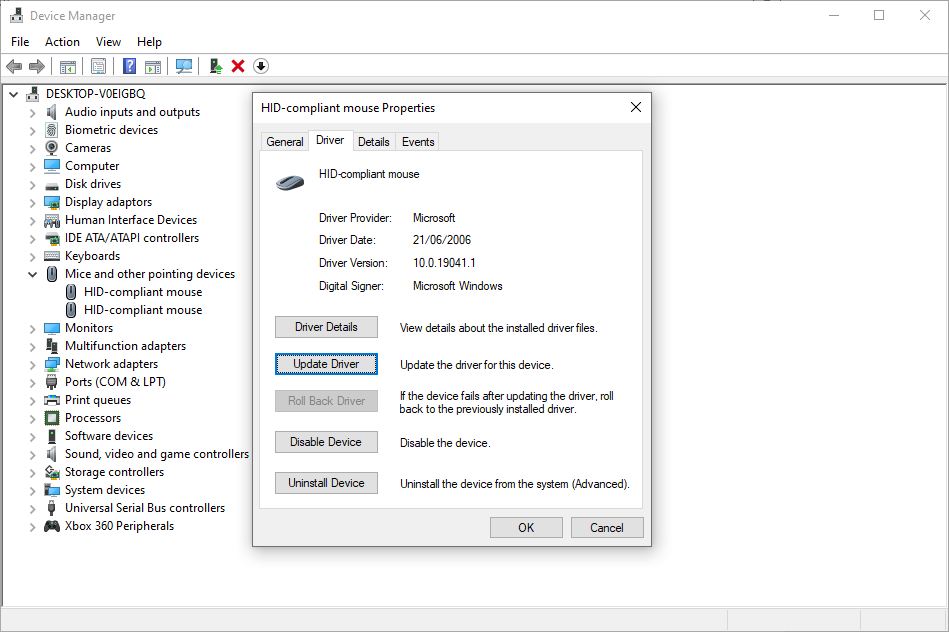
If You Have the Correct Driver
If you have downloaded the correct driver, you should Browse my computer for driver software. On the next page, use the Browse option to locate the driver, then press Next. The driver will install. Reboot your system when it completes.
If You Do Not Have the Correct Driver
If you haven't downloaded a driver directly from the manufacturer, select Search automatically for updated driver software. Windows will now automatically scan your computer and the internet for any driver updates and install accordingly. Windows will inform you if there are no updates available.
There Is No Driver Update Available
In the event there is no driver update available, you can try reinstalling the mouse driver manually. Note the name of your mouse or touchpad in the Device Manager, then head to the manufacturer's website. The manufacturer should provide a download of the latest version of your mouse driver.
If you cannot find the relevant download on the manufacturer's site, complete an internet search for "[PC model] windows 10 mouse driver" or "[laptop model] windows 10 touchpad driver." It should turn up the correct driver for your hardware.
Once you download the new mouse driver, head back to the Device Manager. Then, back to Mouse Properties and the Device tab. Select Uninstall and follow the instructions. Now, install the mouse driver you downloaded manually, and restart your system (see If You Have the Correct Driver, above).
2. Mouse Freezing and Disappearing Cursor
A common Windows 10 mouse issue relates to the Realtek HD Audio Manager. Unfortunately, the Realtek HD Audio Manager is a culprit for audio driver issues, too.
- Right-click the Taskbar, select Task Manager, and head to the Start-up tab.
- If you see Realtek HD Audio Manager, right-click and select Disable.
- Now, reboot your system.
Disabling the Realtek HD Audio Manager is known to fix both mouse freezing and disappearing cursor issues.
3. Mouse Lagging and Beeping Sound
Your third mouse issue fix is another driver-related issue. Your mouse lags and emits a strange beeping sound. Microsoft first addressed these issues way back in April 2016, with Cumulative Updates KB3147458 and KB3147461.
However, you'll benefit from attempting the following fix if you're still experiencing some Windows 10 mouse lag.
- Head to the Device Manager and locate Human Interface Devices. If you see XINPUT Compatible HID or HID-compliant vendor- listed, this fix may well work for you.
- Right-click and select Update Driver Software.
- Select Browse my computer for driver software, followed by Let me pick from a list of device drivers on my computer.
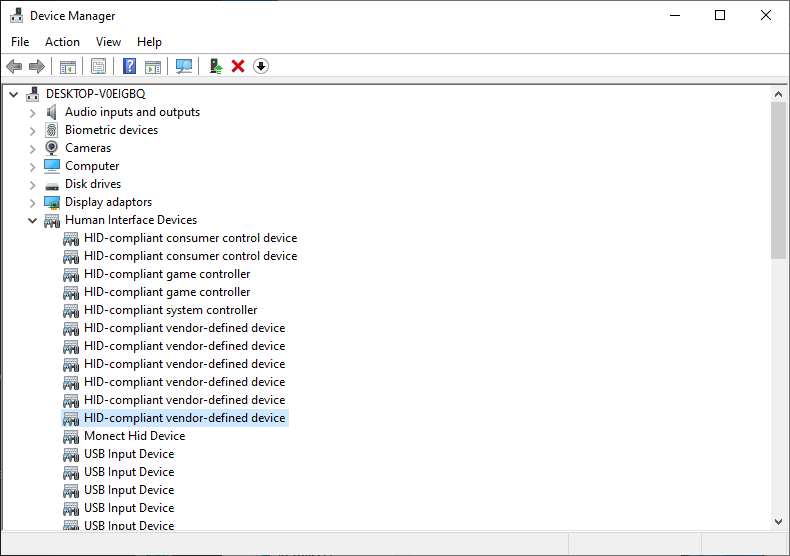
On the next screen, select Have Disk. This allows you to browse the system for a driver of your choice. Locate the extracted files using the Browse button. Select xinputhid or HID-compliant device, then Open > OK.
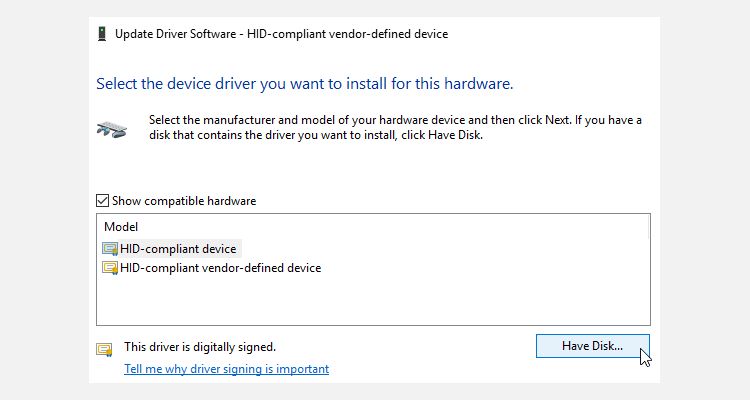
You should now return to the driver selection screen, where the "new" driver will be available for selection. Press Next, then reboot your system.
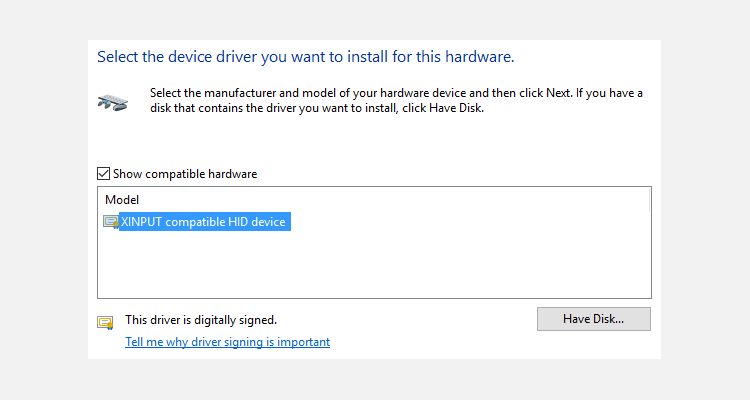
Please note that the Human Input Device (HID) listing may vary from system to system. This fix has been shown to work on a variety of systems, using different hardware setups.
4. Windows 10 Touchpad Freezing
Some Windows 10 users report touchpad freezing issues while using a laptop. The touchpad freezing or jumping issues usually stem from out-of-date touchpad drivers, depending on the device manufacturer.
The process of updating your Windows 10 touchpad settings is similar to a regular mouse.
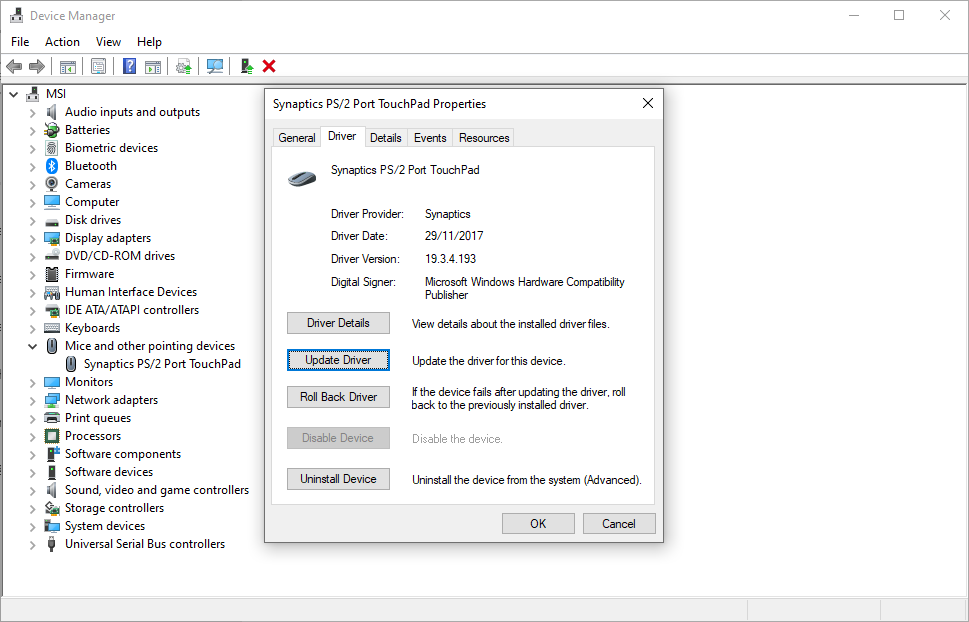
- Type device manager in your Start Menu search bar and select the Best Match.
- Browse to Mice and other pointing devices and unfurl using the arrow.
- Right-click your touchpad driver and select Update Driver > Search automatically for drivers.
Manufacturer Touchpad Settings
Depending on the device manufacturer or touchpad manufacturer, you may have a second set of touchpad settings lurking somewhere on your system. When your Windows 10 touchpad starts acting strangely, it could be that a setting has gone awry.
In the touchpad screenshot above, you'll note the name Synaptics PS/2 Port Touchpad. The manufacturer's name is Synaptics, so that's the manufacturer settings or control panel I'll search for. You can find your touchpad manufacturer name using the Device Manager. Alternatively, some manufacturers insert an extra tab into the Windows 10 Mouse Properties.
- Input mouse in the Start menu search bar and select the Best Match.
- Select Additional mouse options.
- Check for an extra tab with the manufacturer or touchpad name or similar.
- Adjust any settings that seem broken, or alternatively, restore the touchpad settings to the default configuration.
The above process may vary between manufacturers but gives you a rough outline of what to expect.
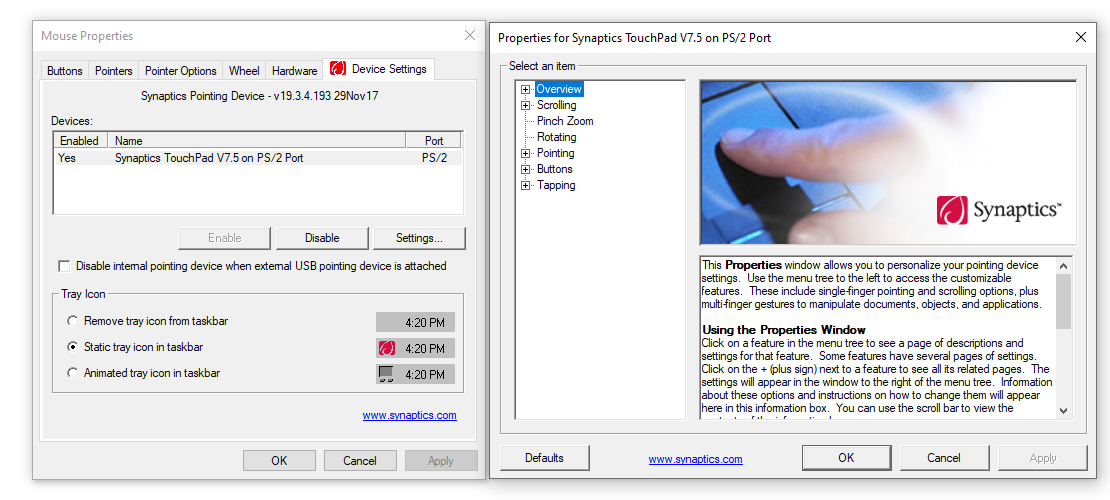
5. Mouse Acceleration
A mouse acceleration issue is incredibly frustrating, especially for the gamers among us. You're lining up a headshot, and BAM! Your mouse drifts to the opposite side of the screen, and you're staring at a respawn screen.
Windows 10 users report mouse acceleration issues in several scenarios. There's no single fix for the mouse acceleration issues, but you can try some of the fixes below to see which one works for you.
Turn Mouse Acceleration Off and On
First, try turning mouse acceleration on and off in your system settings.
- Head to Control Panel > Hardware & Sound > Mouse.
- Select the Pointer Options tab.
- Uncheck the Enhance pointer precision box to turn acceleration off.
- Select Apply and OK. Check how your mouse now responds.
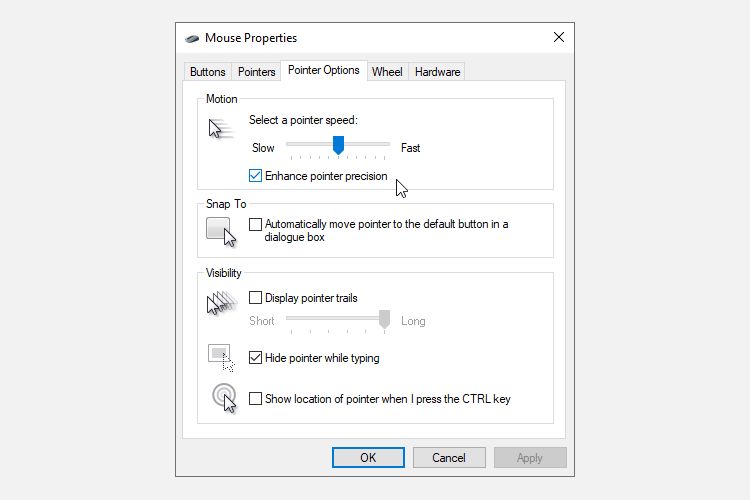
MarkC Mouse Fix
If the good old "Have you tried turning it off and on" doesn't work, you can try to use the MarkC Mouse Fix to fix your Windows mouse acceleration problem. The MarkC Mouse Fix is a registry file that removes Windows 10 mouse pointer acceleration, readjusting the feature to the level of accuracy you would expect.
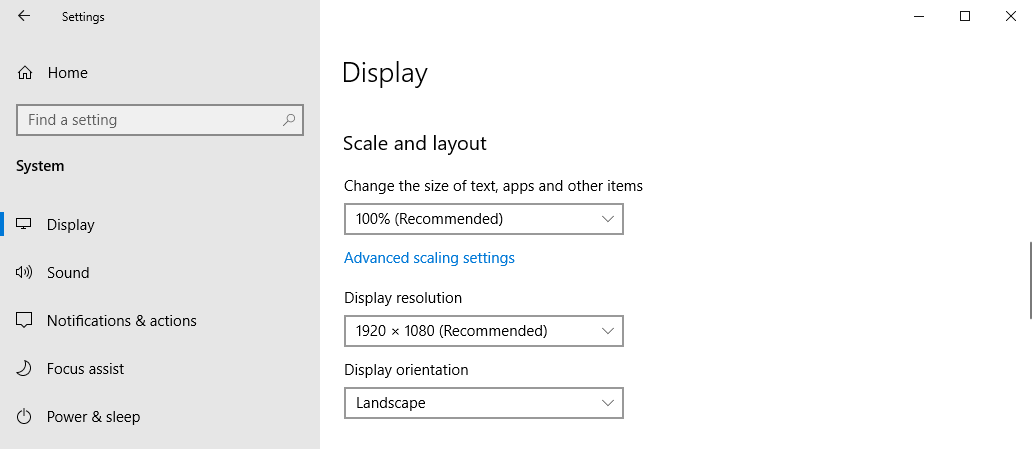
- First up, download the MarkC Mouse Fix compressed file and extract it to a memorable location.
- Next, you need to find out the display DPI (Dots Per Inch) you're currently using by pressing Windows Key + I, then heading to System > Display.
- Under Scale and layout, check the current settings you're using. For example, 100% (Recommended) is the default scale option. Depending on your screen size and resolution, you may see scaling options up to 350 percent.
- Make a note of the current scale settings.
- Head back to the extracted MarkC Mouse Fix folder, locate your version of Windows, and open the folder.
- Select the registry file that corresponds with your display DPI, then double-click to import the file. Answer Yes or OK to the prompts that appear. Now reboot your system for the fix to complete.
You should now enjoy exact 1-to-1 mouse control, with no acceleration or pausing between movements.
Mouse Issues and the Xbox Game Bar
The Xbox Game Bar, formerly known as the Windows 10 Game Bar, is a handy feature for gamers. Sure, other options can record and stream your games. But Microsoft knows that the Xbox Game Bar integration with Windows 10 gives it an edge with gamers who use both a desktop and an Xbox.
Anyway, back to the Windows 10 mouse problems. The Xbox Game Bar in Windows 10 can trigger a mouse acceleration issue. Unfortunately, it isn't a uniform problem. As such, there isn't a definite fix. Some users report that other mouse acceleration fixes have a positive effect. Others have gone so far as to remove the built-in game features completely via the Windows PowerShell.
A common theme for those experiencing mouse acceleration problems while using the Windows 10 Game Bar is using the Windows Key + G shortcut to trigger a recording event. Try it for yourself and note if your mouse acceleration issue starts afterward.
6. Nvidia Drivers
After every Windows 10 update, users report mouse issues in certain environments or scenarios. Specifically, the mouse buttons continue working, but the movement stops.
One common fix for this issue stems from outdated Nvidia drivers.
To update your Nvidia drivers, first head to the Nvidia drivers page. Select your Nvidia product from the dropdown boxes, then select Start Search. The latest drivers for your Nvidia graphics card will appear in the results below. Download and install the latest version.
7. Fix Mouse Issues With the Hardware Troubleshooter
Windows 10 includes several troubleshooters you can use in an attempt to identify and fix mouse issues automatically. The success of these troubleshooters varies depending on the issue, and you might have to take their suggestions with a grain of salt.
For example, the Wi-Fi troubleshooter often suggests a complete network reset, restoring your settings to default if your internet drops out, rather than just suggesting switching the router off and on first.
To find the Windows 10 hardware troubleshooter:
- Press Windows Key + I to open the Settings panel.
- Head to Updates & Security > Troubleshoot.
- Under Hardware and Devices, select Run the troubleshooter.
Windows 10 will attempt to detect any mouse issues, then ask if you want to apply a fix.
Solving Windows 10 Mouse Problems
I hope one of the fixes sorts your Windows 10 mouse or touchpad issue out. The Windows Update system always has a chance of breaking something, somewhere. That Microsoft has relaxed Windows 10's previously stringent update rules can only help end-users. If a buggy update isn't installed automatically, you stand a better chance of steering clear of time-consuming mouse-related bugs.
0 Comments